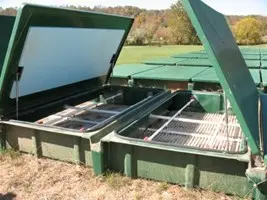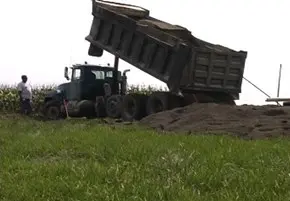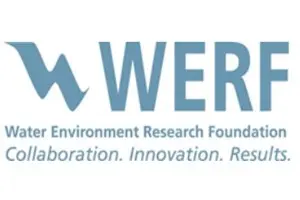Alternative Wastewater Solutions Committee
Gravity sewers are not a one-size-fits-all solution to wastewater management. Local context, such as lot sizes, population density, and soil conditions, all affect the cost-effectiveness of wastewater solutions.
The Alternative Wastewater Solutions Committee was established to investigate new approaches for addressing the wastewater needs of small, rural communities in Ohio. RCAP and the committee help communities consider a greater range of options.
If you are interested in attending the next committee meeting or would like additional information, please contact Ben Howard.
Background

Wastewater infrastructure is expensive, but affordable when you have enough customers to share in the costs. Increasingly, communities facing wastewater challenges have small populations and many failing household on-site septic systems. In the past, a limited number of Ohio communities were fortunate enough to take advantage of limited grant funding such as 20% grants and research and development funds from the Ohio Water Development Authority. But many communities could not access affordable financing for wastewater infrastructure during the 1990s and 2000s.
An important exception occurred in the village of Amesville. In 2008, the village installed a small diameter effluent sewer and textile media-based treatment system. Amesville is unique in that it involves multiple discharge points on one NPDES permit and requires a Class A operator (lowest certification). The village successfully maintained its O&M costs at around $15,000 annually over the last 10 years. The Amesville example is an outlier, rather than the norm.
Since 2008, more systems have been installed in rural Ohio with a variety of gravity, STEP, and STEG collection systems. These systems are possible because of critical principal forgiveness funds available through the State Revolving Loan Fund from Ohio EPA and the Unsewered Areas Grant from the Ohio Water Development Authority. These efforts have abated environmental and public health threats.
Still, financial concerns remain, particularly for communities with fewer than 300 connections.
Technical Considerations
Examples
Generally, in Ohio, excess nutrient loading by on-site septic systems to soil is not the issue. It is the hydraulic loading that is problematic for many on-site systems. When lots are too small to infiltrate the flows, an off-site cluster system serving several homes may be possible.
However, prior to the beginning of operations a means for individual homeowner accountability and payment of maintenance costs must be established . Home owner associations have historically been observed to be ineffective managers of cluster systems and are generally no longer allowed as an option.
Below follow some examples where on-site system were not feasible, but community-wide soil based solutions could effectively and affordably treat their sewage.
The first example is from Tuppers Plains Regional Sewer District in Meigs County, OH. The system uses spray irrigation from their lagoon system, safely returning the water to the soil. Importantly, this system does not have an NPDES permit as there is no discharge to any waterway. Instead, spray irrigation systems require a Land Application Management Plan that is regularly reported to OEPA. This has allowed for effective, affordable operations leveraging natural processes to keep capital and operational costs low.

Tuppers Plains Regional Sewer District

Adamsville Constructed Wetlands WWTP - Operated by Muskingum County
A second example of a 'non-discharging' system is found in Adamsville, OH. The system is a constructed wetland, which involves even lower regulatory compliance related costs as the system hydraulic flows are safely returned to the soil subsurface. These treatment facilities require a permit to install and, if serving more than 20 people, require a one-time registration as an injection well with the Ohio EPA Division of Drinking and Ground water. The system does not involve an ongoing O&M permit, only internal record keeping that must be available for review at the request of the OEPA, if problems arise.
This scenario may be attractive for small communities as a way to keep costs down since the staffing requirement for a licensed operator and the ongoing reporting requirements do not apply. Nonetheless, these systems require a skilled and dedicated operator. For small communities without experience running a utility that want to pursue this approach, collaborating with your county government is key.
Both these examples handle hydraulic flows through infiltration in the soil, which is ecologically preferable. However, the local context may not allow for this, so treatment and disinfection prior to discharge in a waterway may be the most economic approach, as large tracts of land to safely handle the hydraulic flows are too costly. Above mentioned Amesville, OH is one such example of a successful discharging system.
SAND BIO-REACTORS
On the committee, Dr. Karen Mancl of The Ohio State University's Food, Agricultural, and Biological Engineering Department has highlighted the strengths of sand bioreactor systems. They involve maintenance / reporting once a month, involve one pump and no aerator resulting in low energy costs, and finish with U/V disinfection.

Tools
Management of Wastewater Canvas
This one-pager succinctly documents key components for developing sewer service in an unserved area. Use this template and fill it out according to your community's situation. Here's a generic example. Use the link below and make it your own.
Management of Wastewater Template
USDA Soil Survey
The USDA Natural Resources Conservation Service has soil maps and data available online for more than 95 percent of the nation’s counties and anticipates having 100 percent in the near future. Soil surveys can be used for general farm, local, and wider area planning. Onsite investigation is needed in some cases, such as soil quality assessments and certain conservation and engineering applications. The data available here is a great starting point for preliminary planning.
OHIO - TECHNOLOGY COST CALCULATOR
There have been several developments such as small diameter sewers, fixed media treatment units, affordable U/V disinfection that have made treatment simpler, easier to operate, and more affordable for some communities.
To facilitate appropriate technology selection for a community, the committee investigated surveying alternative systems in Ohio. During this process we learned of the Water Environment Research Foundation’s Decentralized Planning Tool.
The tool’s development was led by John Buchanan at the University of Tennessee – Knoxville and he generously adapted the tool to Ohio regulations for soil loading rates.
This tool can be useful in helping communities begin to understand the potential costs involved in establishing a wastewater utility.
Additional guidance regarding the tool and the Options by Process Charts (pgs 22-24) are available here. Explanatory notes of the tool are available here.

Funding
Funding on-site systems has been a tricky question, the use of public funds on private property. Limited funds are available and are based on income eligibility. Many health districts in Ohio receive limited grant funding through the State Revolving Fund. These funds are used to address urgent needs on low-income properties. An important caveat is that rental properties are ineligible as these are regarded as businesses, so improvements must be paid for by the owner.
More funding options are available if the assets are owned by the utility. Ownership can be achieved through a center-line easement 5’ either side of wastewater infrastructure assets. An example of strategic use of utility funds on private property is Avon Lake, OH, which used SRF funds to improve sewer laterals as a means to prevent inflow and infiltration. This was possible through local legislation authorizing the establishment of a revolving loan fund with 0% interest over 10 years with funds from the Ohio SRF program, whereby the utility makes loans at 2% (to cover administrative costs) to homeowners to pay for a contractor to complete the sewer lateral repair / replacement work. The homeowners then pay off the loan each month on their sewer bills.
The committee is similarly seeking creative financing mechanisms to keep on-site systems properly managed in a cost-effective manner. We are exploring options such as the Local Revolving Loan Fund, Establishment of a Septage Management District for administration by a third party, and even privatized out-sourcing.
Privatized outsourcing has gained significant traction in Tennessee. This is accomplished through the community hiring a design-build firm with an exclusive contract to manage the system. This allows the private firm to make the significant up-front investment and be confident they can recover their costs over time. One firm reported signing a 99 year lease contract. One barrier is that in such a scenario the system would not be a public treatment works and the primacy agency would not have the authority to require rate adjustments. The system would be governed by the public utility commission.
This design-build approach is problematic when it comes to leveraging SRF monies as it is done through the Professional Service RFQ process, not competitive bidding. That and the lack of control of rates to ensure repayment of loan dollars has meant the out-sourcing solution has not been implemented with SRF monies in Ohio.
The committee has recently been focused on the best means for the establishment and operation of a Responsible Management Entity (RME) that has the necessary TMF capabilities and eligibility to receive SRF monies. This is an on-going effort to reconcile the various needs for small rural systems to achieve technical, management, and financial capabilities for long-term sustainability.

Management Considerations
Status quo attitudes for many system managers and operators is to sewer, treat, and discharge. There’s a need to change to a more system-wide view that prioritizes anti-degradation through non-discharging systems. ‘Anti-degradation’ needs to be a goal.
In some areas of Ohio that are growing and with adequate incomes, irrigation based systems have been used successfully, e.g. Delaware County, which has around 50 systems dispersing flows on golf courses.
New buildings, especially those seeking sustainability through certifications such as LEED, can more easily address nutrient management because financial resources are available.
In areas with ecologically sensitive areas, such as ponds or lakes, nutrient loading issues are more apparent and typically spur pro-active decisions by lakeside communities. Though this is not always the case. For example, one Central Ohio lakeside community fought installation of the sewer and was forced due to findings and orders.
In areas that are enjoying growth and new construction, there are often more options and financial resources available to solve wastewater challenges. The committee is working hard to develop ways to identify issues and promote proactive decision-making that widens the options for long-established, small rural communities. The work surrounding Responsible Management Entities (RME) is central to this effort. Stay tuned as our progress continues.


